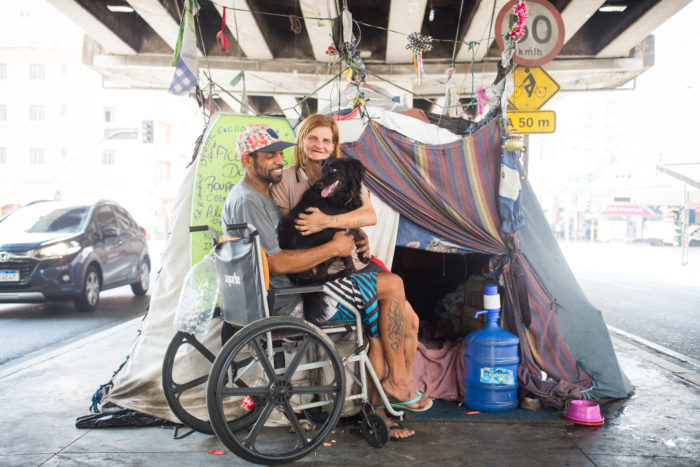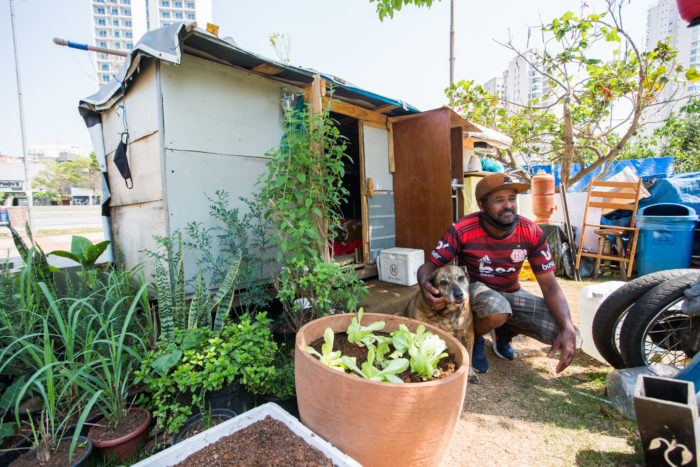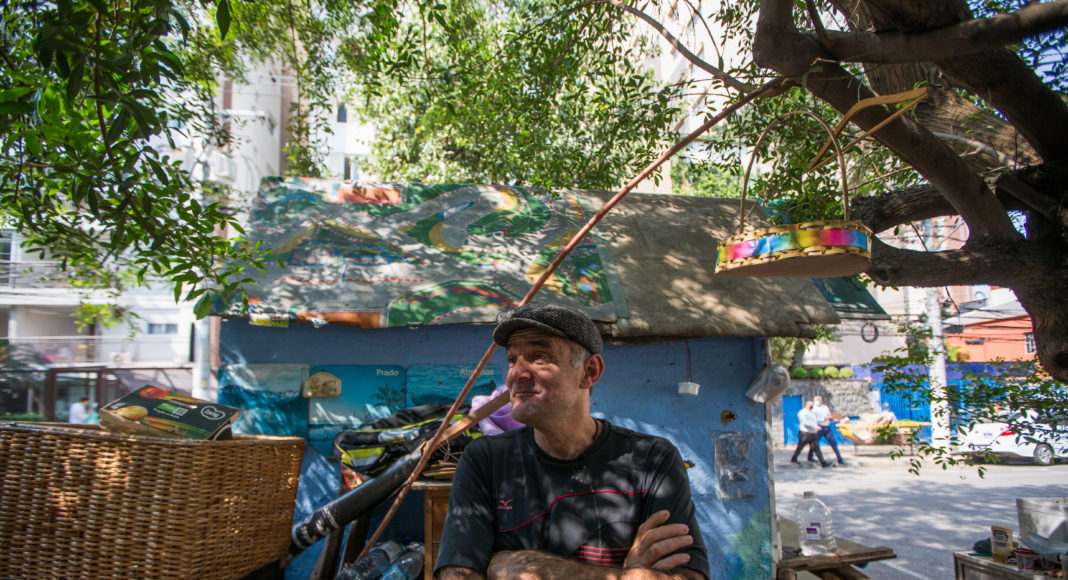According to an estimate carried out last year by the city’s Office of Social Assistance and Development, the number of people experiencing homelessness on the streets of São Paulo grew from 24,344 in 2019 to almost 31,884 in the 2021 – an increase of 31 per cent, exacerbated by the socio-economic implications of the Covid-19 pandemic.
A documentary produced by Fraya Frehse, professor of sociology at the University of São Paulo, in collaboration with the Architecture Museum of the Technical University of Munich, uses the lens of street architecture to examine this crisis and the experiences of those who it has affected.
Usually carried out every four years, last year’s census was brought forward so that it could guide the city administration and help them design an emergency response plan to tackle this crisis. The aim is to support both the formerly homeless as well as people currently experiencing homelessness. The current local administration seems to be genuinely devoted to creating solutions, putting in action an assistance program based on three principles: connection, care, and opportunity. The goal is to provide services and support to those in need of permanent housing, including shelter, income and rent support, temporary housing, professional training, and work placement. However, increasing public housing is no easy feat and it will require a huge effort.
As in other expensive metropolises, the pandemic’s financial impact in São Paulo hit hard. Many families, including families with children, were evicted from their homes. The census showed that the number of people claiming to be living on the street in family groups was also up by 8.6 per cent, accounting for 30 per cent of the current homeless population. The number of women and LGBTQI people experiencing homelessness has also increased.
Resourceful construction
Another striking result refers to the number of what the census denominates ‘makeshift housing’ (tents) in the streets. There has been a steep increase of 330 per cent, from 2,051 units in 2019 to 6,778 in 2021, reflecting the increase of families experiencing homelessness. Frehse looks at three such homes and interviews the people who built and inhabit them. Frehse’s documentary depicts the resourcefulness, creativity and skills behind this impromptu building. Through the lens of street architecture, it shows how the street has been occupied and modified by those who find themselves inhabiting it.
The first belongs to a couple, Junior and Cecilia, and their dog. It is a remarkable design: inspired by an advert for a circus, Junior has used lengths of twine tied to weighted bottles to suspend a tent of recycled materials from hooks on the bridge beneath which they live.

The next two interviewees, João and Cleberson, have both built structures on top of carts from materials found in scrap yards or on the street. João’s house is stationed on a patch of grass. He has established a kind of garden around it, where he grows herbs and sells recycled bottles. Kleberson’s house is currently in a parking bay on a central street, and from it, he operates a carpentry business.
From place of movement to dwelling-place
The documentary demonstrates how the street has changed from a place primarily of transit to one of semi-permanent dwelling, with all the complex social relations that come with that. This is not a new phenomenon. However, the exponential increase in homelessness as a result of the pandemic, particularly in São Paulo, means that this is an increasingly visible and prominent aspect of the ‘street’ as it exists today.
The documentary responds to this increase by drawing attention to the complexity of the street as experienced by its homeless population, ideas articulated in the accompanying essay ‘On the Spatialities of the Homeless’ Street in Covid-19 São Paulo’ 1)Frehse, F. (2021). In: Lepik, A., D. Talesnik (eds.). Who’s Next? Homelessness, Architecture, and Cities. München, Architangle, 92-96.
One such spatiality expressed by those Frehse interviews for this essay relates to the usage of the street, both as a place of movement and of dwelling. This comes with its own intricacies: she notes the distinction made by various people she interviewed between those who sleep on the sidewalk, and those who live on the street, divided along the lines of the transience/permanence of their presence on the street.

This tension between movement/dwelling or transience/permanence is obvious in the documentary: the houses it looks at are temporary, as they are small, makeshift and, in the case of João and Kleberson, mobile. However only Junior and Cecilia speak of leaving the street. Indeed, for Kleberson, the street has been his home for decades. While it may be imagined by many as a place one only passes through, in reality the street becomes a permanent dwelling space for many others, especially when there is so little social housing available.
Frehse also suggests that the street has a non-physical aspect, as an existential experience for those who live there, one that comes with complex emotional experiences. Those interviewed in the essay describe it as a ‘life phase’ and explain how one must ‘learn to live on the street’. In the documentary, Junior describes how he intends to build more such tents under the same bridge, for other people who will go through the same thing he is going through, an intention which speaks to the shared emotional experience of the street, and the ways one finds to survive.
The street is also imagined as a social institution, with rules and moral codes to which its inhabitants adhere. Those she interviews say that one must ‘learn how to enter and exit the street’. Those in the documentary speak of the social relationships they have with those around them: the giving and receiving of aid from both the home-owning and home-less inhabitants of the neighbourhood.

All of this is detailed in order to express the challenges that the intricate socio-spatial nature of the street poses to architects wishing to design alternative accommodation for the homeless. Frehse proposes that any social housing scheme aimed at this population must take into account the complexity of the experience of homelessness.
For example, it must allow for the differing needs of more temporary ‘sidewalk dwellers’ and more permanent ‘street dwellers’. It must also take into account the stark emotional transitions of entering and leaving the street, and acknowledge the social systems that have developed around the street.
In looking at the homes that people have built for themselves, and the social and emotional processes undergone in order to do so, the architect can find a model for the varying needs and desires of people who have experienced homelessness.
The book: Lepik, A., D. Talesnik (eds.). Who’s Next? Homelessness, Architecture, and Cities. München, Architangle can be obtained here.
The Film: Street Architecture in Covid-19 São Paulo will be on view in Hamburg Kunst & Gewerbe Museum between 14 October 2022 and 12 March 12 2023.
– Direction, Screenplay, Technical Revision & Narration: Fraya Frehse
– Cinematography & Editing: Bruno Nogueirão
– Photography & Camera: Tiago Queiroz
– Subtitles & English Translation: Paulo Scarpa
– German Translation: Rainer Domschke
– Production: Fraya Frehse & Architekturmuseum der Technischen Universität München
Commissioned for the Exhibition “Who’s Next? Obdachlosigkeit, Architektur und die Stadt / Homelessness, Architecture, and Cities“ – Architekturmuseum der Technischen Universität München
– Curator: Daniel Talesnik
– Collaboration: Ella Neumaier, Ilyas Kerem Yilmaz, Ann-Kathrin Gügel, Theresa Thanner, Anna-Maria Mayerhofer
– Graphic Design: Kathryn Gillmore
– Exhibition Architecture: Carmen Wolf
References
| ↑1 | Frehse, F. (2021). In: Lepik, A., D. Talesnik (eds.). Who’s Next? Homelessness, Architecture, and Cities. München, Architangle, 92-96 |
|---|

